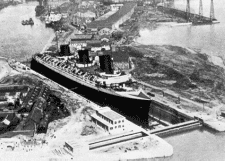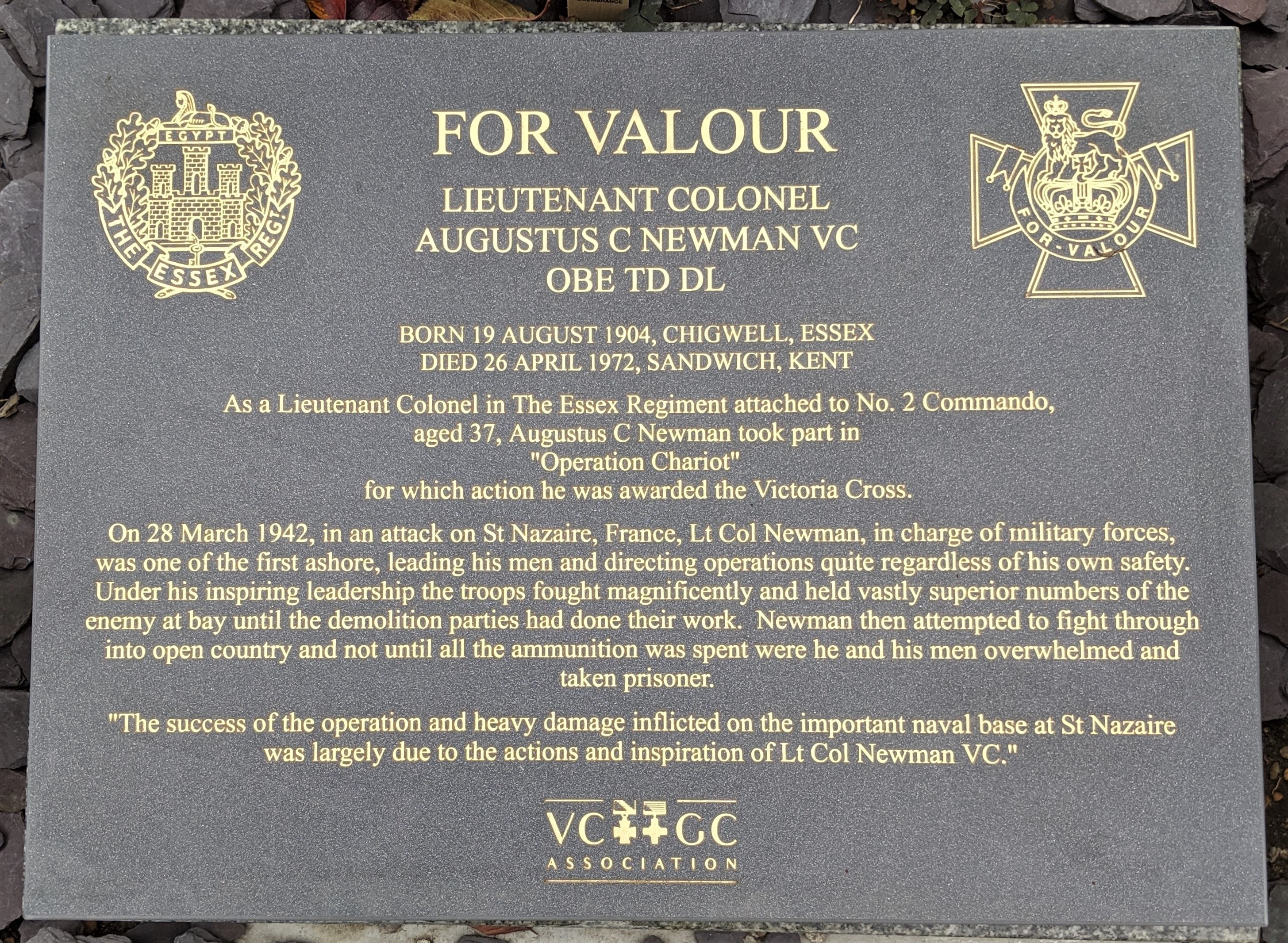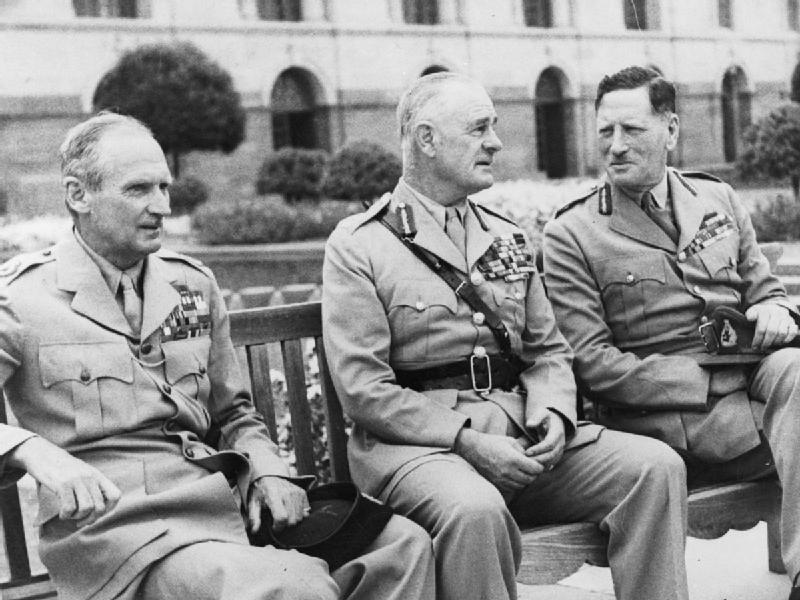|
Operation Musketoon
Operation Musketoon was the codeword of a British–Norwegian commando raid in the Second World War. The operation was mounted against the German-held Glomfjord power plant in Norway from 11 to 21 September 1942. The raiders consisted of two officers and eight men from No. 2 Commando and two men of the Norwegian Armed Forces in exile who were part of the Special Operations Executive. Crossing the North Sea by submarine, on arrival in Norway they attacked and damaged the plant, which was closed for the rest of the war. To evade German search parties, the commandos split into two groups. One group of four men reached Sweden and were eventually repatriated to the United Kingdom. The second group was captured; one man died of wounds and the other seven were taken to Germany, interrogated and then executed at Sachsenhausen concentration camp. Background After the British Expeditionary Force had been evacuated from Dunkirk in Operation Dynamo in 1940, the Prime Minister Winston Chu ... [...More Info...] [...Related Items...] OR: [Wikipedia] [Google] [Baidu] |
Second World War
World War II or the Second World War, often abbreviated as WWII or WW2, was a world war that lasted from 1939 to 1945. It involved the vast majority of the world's countries—including all of the great powers—forming two opposing military alliances: the Allies and the Axis powers. World War II was a total war that directly involved more than 100 million personnel from more than 30 countries. The major participants in the war threw their entire economic, industrial, and scientific capabilities behind the war effort, blurring the distinction between civilian and military resources. Aircraft played a major role in the conflict, enabling the strategic bombing of population centres and deploying the only two nuclear weapons ever used in war. World War II was by far the deadliest conflict in human history; it resulted in 70 to 85 million fatalities, mostly among civilians. Tens of millions died due to genocides (including the Holocaust), starvation, ma ... [...More Info...] [...Related Items...] OR: [Wikipedia] [Google] [Baidu] |
Lieutenant-Colonel
Lieutenant colonel ( , ) is a rank of commissioned officers in the armies, most marine forces and some air forces of the world, above a major and below a colonel. Several police forces in the United States use the rank of lieutenant colonel. The rank of lieutenant colonel is often shortened to simply "colonel" in conversation and in unofficial correspondence. Sometimes, the term 'half-colonel' is used in casual conversation in the British Army. In the United States Air Force, the term 'light bird' or 'light bird colonel' (as opposed to a 'full bird colonel') is an acceptable casual reference to the rank but is never used directly towards the rank holder. A lieutenant colonel is typically in charge of a battalion or regiment in the army. The following articles deal with the rank of lieutenant colonel: * Lieutenant-colonel (Canada) * Lieutenant colonel (Eastern Europe) * Lieutenant colonel (Turkey) * Lieutenant colonel (Sri Lanka) * Lieutenant colonel (United Kingdom) * Lie ... [...More Info...] [...Related Items...] OR: [Wikipedia] [Google] [Baidu] |
St Nazaire Raid
The St Nazaire Raid or Operation Chariot was a British amphibious attack on the heavily defended Normandie dry dock at St Nazaire in German-occupied France during the Second World War. The operation was undertaken by the Royal Navy (RN) and British Commandos under the auspices of Combined Operations Headquarters on 28 March 1942. St Nazaire was targeted because the loss of its dry dock would force any large German warship in need of repairs, such as , sister ship of , to return to home waters by running the gauntlet of the Home Fleet of the Royal Navy and other British forces, via the English Channel or the North Sea. The obsolete destroyer , accompanied by 18 smaller craft, crossed the English Channel to the Atlantic coast of France and was rammed into the Normandie dry dock south gate. The ship had been packed with delayed-action explosives, well hidden within a steel and concrete case, that detonated later that day, putting the dock out of service until 1948. A force o ... [...More Info...] [...Related Items...] OR: [Wikipedia] [Google] [Baidu] |
Operation Archery
Operation Archery, also known as the Måløy Raid, was a British Combined Operations raid during World War II against German positions on the island of Vågsøy, Norway, on 27 December 1941. British Commandos of No. 3 Commando, two troops of No. 2 Commando, a medical detachment of No. 4 Commando, a demolition party from 101 Troop (canoe) of No. 6 Commando, and a dozen Norwegians from Norwegian Independent Company 1 conducted the raid. The Royal Navy, led by the light cruiser , with the destroyers , , and , provided fire support.''London Gazette'', 2 July 1948. The submarine was in support as the force navigational check. and transported the troops. Also in support were Royal Air Force bombers and fighter-bombers. Objectives Central to the operation was the destruction of fish-oil production and stores which the Germans used in the manufacture of high explosives. Another intention was to cause the Germans to maintain and increase forces in Norway, which would reduce force ... [...More Info...] [...Related Items...] OR: [Wikipedia] [Google] [Baidu] |
Troops
A troop is a military sub-subunit, originally a small formation of cavalry, subordinate to a squadron. In many armies a troop is the equivalent element to the infantry section or platoon. Exceptions are the US Cavalry and the King's Troop Royal Horse Artillery where a troop is a subunit comparable to an infantry company or artillery battery. Historically the remainder of the Royal Horse Artillery used the term Troop in the same manner however they are now aligned with the rest of the Royal Regiment of Artillery in referring to Troops as subordinate to artillery batteries. Troops is often used to refer to the other members of one's company or cause, but because of its military connotations, it conveys a particularly altruistic type of dedicated worker. Traditionally, troops refers to the soldiers in a military. A cavalry soldier of private rank is called a trooper in many Commonwealth armies (abbreviated "Tpr", not to be confused with "trouper"). A related sense of the ... [...More Info...] [...Related Items...] OR: [Wikipedia] [Google] [Baidu] |
Augustus Charles Newman
Lieutenant Colonel Augustus Charles Newman, (19 August 1904 – 26 April 1972) was a British Army officer and recipient of the Victoria Cross, the highest award for gallantry in the face of the enemy that can be awarded to British and Commonwealth forces. Details Newman was educated at Bancroft's School, Essex. On leaving school he joined a firm of Civil Engineering and Public Works Contractors and was commissioned into the part-time Territorial Army in 1925, rising to the rank of major by 1939. He was 37 years old and a lieutenant colonel in The Essex Regiment, British Army, attached to No. 2 Commando during the Second World War, when the following deed took place for which he was awarded the Victoria Cross (VC). On 28 March 1942 in the attack on St. Nazaire, France, Lieutenant Colonel Newman was in charge of the military forces and he was one of the first ashore, leading his men and directing operations quite regardless of his own safety. Under his inspiring leadership ... [...More Info...] [...Related Items...] OR: [Wikipedia] [Google] [Baidu] |
Lieutenant Colonel
Lieutenant colonel ( , ) is a rank of commissioned officers in the armies, most marine forces and some air forces of the world, above a major and below a colonel. Several police forces in the United States use the rank of lieutenant colonel. The rank of lieutenant colonel is often shortened to simply "colonel" in conversation and in unofficial correspondence. Sometimes, the term 'half-colonel' is used in casual conversation in the British Army. In the United States Air Force, the term 'light bird' or 'light bird colonel' (as opposed to a 'full bird colonel') is an acceptable casual reference to the rank but is never used directly towards the rank holder. A lieutenant colonel is typically in charge of a battalion or regiment in the army. The following articles deal with the rank of lieutenant colonel: * Lieutenant-colonel (Canada) * Lieutenant colonel (Eastern Europe) * Lieutenant colonel (Turkey) * Lieutenant colonel (Sri Lanka) * Lieutenant colonel (United Kingdom) * L ... [...More Info...] [...Related Items...] OR: [Wikipedia] [Google] [Baidu] |
1 PARA
The 1st Battalion, Parachute Regiment (1 PARA), is a battalion of the British Army's Parachute Regiment. Along with various other regiments and corps from across the British Armed Forces, it is part of Special Forces Support Group. A specialized airborne light infantry unit, the battalion as of 2006 has been the main contributor of manpower to the British Army's Parachute Regiment and is capable of a wide range of operations. Personnel regularly deploy outside the United Kingdom on operations and training, 1 PARA is part of Special Forces Support Group and regarded as the elite of the Parachute Regiment deployed to assist United Kingdom Special Forces in a supporting role as well as being the main part of the hunter force on SF selection. All personnel complete the Pre Parachute Selection ( P Company) course at the Infantry Training Centre Catterick Garrison, North Yorkshire (previously at Aldershot, Hampshire). History The 1st Battalion can trace its origins to 1940, w ... [...More Info...] [...Related Items...] OR: [Wikipedia] [Google] [Baidu] |
Parachute
A parachute is a device used to slow the motion of an object through an atmosphere by creating drag or, in a ram-air parachute, aerodynamic lift. A major application is to support people, for recreation or as a safety device for aviators, who can exit from an aircraft at height and descend safely to earth. A parachute is usually made of a light, strong fabric. Early parachutes were made of silk. The most common fabric today is nylon. A parachute's canopy is typically dome-shaped, but some are rectangles, inverted domes, and other shapes. A variety of loads are attached to parachutes, including people, food, equipment, space capsules, and bombs. History Middle Ages In 852, in Córdoba, Spain, the Moorish man Armen Firman attempted unsuccessfully to fly by jumping from a tower while wearing a large cloak. It was recorded that "there was enough air in the folds of his cloak to prevent great injury when he reached the ground." Early Renaissance The earliest evidence f ... [...More Info...] [...Related Items...] OR: [Wikipedia] [Google] [Baidu] |
British Army During The Second World War
At the start of 1939, the British Army was, as it traditionally always had been, a small volunteer professional army. At the beginning of the World War II, Second World War on 1 September 1939, the British Army was small in comparison with those of its enemies, as it had been at the beginning of the World War I, First World War in 1914. It also quickly became evident that the initial structure and manpower of the British Army was woefully unprepared and ill-equipped for a war with multiple enemies on multiple fronts. During the early war years, mainly from 1940 to 1942, the British Army suffered defeat in almost every Theater (warfare), theatre of war in which it was deployed. But, from late 1942 onwards, starting with the Second Battle of El Alamein, the British Army's fortunes changed and it rarely suffered another defeat. While there are a number of reasons for this shift, not least the entrance of both the Soviet Union and the United States in 1941, as well as the Cryptanal ... [...More Info...] [...Related Items...] OR: [Wikipedia] [Google] [Baidu] |
British Commandos
The Commandos, also known as the British Commandos, were formed during the Second World War in June 1940, following a request from Winston Churchill, for special forces that could carry out raids against German-occupied Europe. Initially drawn from within the British Army from soldiers who volunteered for the Special Service Brigade, the Commandos' ranks would eventually be filled by members of all branches of the British Armed Forces and a number of foreign volunteers from German-occupied countries. By the end of the war 25,000 men had passed through the Commando course at Achnacarry. This total includes not only the British volunteers, but volunteers from Greece, France, Belgium, Netherlands, Canada, Norway, Poland, and the United States Army Rangers and Marine Raiders, US Marine Corps Raiders, which were modelled on the Commandos.Moreman, p.40. Reaching a wartime strength of over 30 units and four assault brigades, the Commandos served in all theatres of war from the Arctic C ... [...More Info...] [...Related Items...] OR: [Wikipedia] [Google] [Baidu] |
Chief Of The Imperial General Staff
The Chief of the General Staff (CGS) has been the title of the professional head of the British Army since 1964. The CGS is a member of both the Chiefs of Staff Committee and the Army Board. Prior to 1964, the title was Chief of the Imperial General Staff (CIGS). Since 1959, the post has been immediately subordinate to the Chief of the Defence Staff, the post held by the professional head of the British Armed Forces. The current Chief of the General Staff is General Sir Patrick Sanders, who succeeded his predecessor, General Sir Mark Carleton-Smith, in June 2022. Background The title was also used for five years between the demise of the Commander-in-Chief of the Forces in 1904 and the introduction of Chief of the Imperial General Staff in 1909. The post was then held by General Sir Neville Lyttelton and, briefly, by Field Marshal Sir William Nicholson. Throughout the existence of the post the Chief of the General Staff has been the First Military Member of the Army Boar ... [...More Info...] [...Related Items...] OR: [Wikipedia] [Google] [Baidu] |





